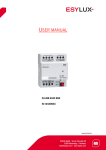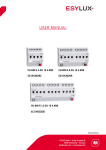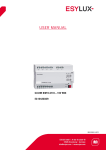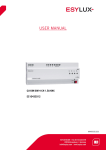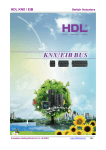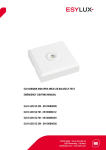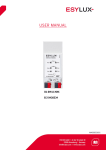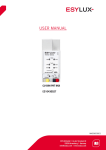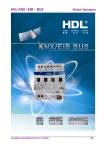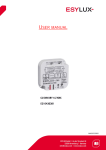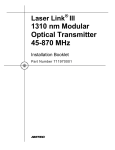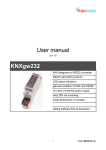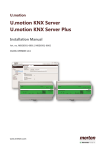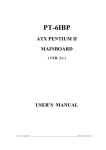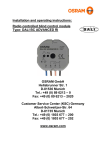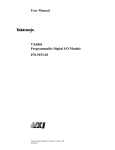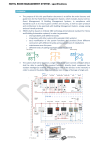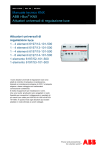Download USER MANUAL
Transcript
USER MANUAL CU-DIN SB 2-CH 10A KNX CU-DIN SB 4-CH 10A EC10430343 KNX EC10430350 CU-DIN SB 6-CH 10A KNX EC10430367 MA00652401 USER MANUAL Table of contents 1 Description ................................................................................................4 2 Safety instructions ......................................................................................4 3 Product function ........................................................................................5 4 Hardware...................................................................................................6 4.1 4.2 4.3 4.4 5 Software ..................................................................................................11 5.1 5.2 5.3 5.4 5.5 6 Technical data ................................................................................ 6 Dimension drawings ........................................................................ 9 Wiring diagram ............................................................................... 9 Maintenance and cautions .............................................................. 11 Database functions - Overview ........................................................ 12 Object/Association/Group address definition ..................................... 14 Function parameter “General” ........................................................ 14 Function parameter “Channel A”..................................................... 17 Channel mode “Blinds” ................................................................. 18 5.5.1 Channel function ............................................................... 21 5.5.2 Channel function “Position” ............................................... 24 5.5.3 Channel function “Safety” .................................................. 26 5.5.4 Channel function “Auto 1” ................................................. 28 5.5.5 Channel function “Auto 2” ................................................. 30 5.5.6 Channel function “Scene” .................................................. 32 Communication objects description ............................................................33 6.1 6.2 Objects “General” and “Output A” .................................................. 33 All objects with channel A .............................................................. 35 6.2.1 Objects “Limit Travelling” .................................................. 35 6.2.2 Objects “Status of Position” ............................................... 36 6.2.3 Objects “Move of Louvre Position” ....................................... 36 6.2.4 Objects “Status of upper pos” ............................................. 36 6.2.5 Objects “Louvre Position Status” ......................................... 37 6.2.6 Objects “Upper position status” .......................................... 37 6.2.7 Objects “Status of lower position” ....................................... 37 6.2.8 Objects “Status of auto” ..................................................... 38 6.2.9 Objects “Status of forced operation” .................................... 38 6.2.10 Objects “Set position 1/2” .................................................. 38 6.2.11 Objects “Set position 3/4” .................................................. 39 6.2.12 Objects “Move to position 1/2” ........................................... 39 6.2.13 Objects “Move to position 3/4” ........................................... 39 CU-DIN SB 2-CH 10 A KNX CU-DIN SB 4-CH 10 A KNX CU-DIN SB 6-CH 10 A KNX 2 / 45 USER MANUAL 6.2.14 6.2.15 6.2.16 6.2.17 6.2.18 6.2.19 6.2.20 6.2.21 6.2.22 6.2.23 6.2.24 6.2.25 6.2.26 Objects “Activation of weatheralarm“ ................................... 40 Objects “Forced operation 1“ .............................................. 40 Objects “Forced operation 1“ .............................................. 40 Objects “Forced operation 2“ .............................................. 41 Objects “Activation of auto control“ ..................................... 41 Objects “Sun = 0 or 1 “ ..................................................... 41 Objects “Move to position for sun“ ...................................... 42 Objects “Adjust louvre for sun“ ........................................... 42 Objects “Enable/Disable remote control“ .............................. 42 Objects “Presence“............................................................ 43 Objects “Heating“ ............................................................. 43 Objects “Cooling“ .............................................................. 43 "Call scene number" objects ................................................ 44 7 Product disposal ......................................................................................44 8 ESYLUX manufacturer´s guarantee .............................................................45 CU-DIN SB 2-CH 10 A KNX CU-DIN SB 4-CH 10 A KNX CU-DIN SB 6-CH 10 A KNX 3 / 45 USER MANUAL 1 Description The ESYLUX KNX/EIB series-switching actuator output modules are developed by ESYLUX. KNX/EIB BUS is used to communicate with other KNX devices. The database needs to be downloaded to the switch actuator by using ETS 3.0F/ETS4/ETS5; the document describes how to use the products. Our products are manufactured according to EMC, electrical safety and environmental standards. The switch actuators are used to control switched loads, such as: Lighting Motor Blinds Heating Other equipment Note: Use this product only as intended (as described in the user instructions). Do not make any changes or alterations as this will render any warrantees null and void. You should check the device for damage immediately after unpacking it. If there is any damage, you should not install the device under any circumstances. If you suspect that safe operation of the device cannot be guaranteed, you should turn the device off immediately and make sure that it cannot be operated unintentionally. 2 Safety instructions Work on the 230 V power system must be carried out by authorized personnel only, with due regard to the applicable installation regulations. Switch off the power supply before installing the system. The 21–30 V KNX bus voltage cannot be used as 24 V operating or auxiliary voltage. Max. relay output: 16 A. CU-DIN SB 2-CH 10 A KNX CU-DIN SB 4-CH 10 A KNX CU-DIN SB 6-CH 10 A KNX 4 / 45 USER MANUAL 3 Product function Shutter/blind actuators can be used for 2, 4 and 6 channels with independent AC loads. The following functions can be set individually for each output channel: Move up/down Stop/louvre adjustment Percentage of position control Position percentage Louvre angle percentage Limit travelling control Response status position status limit position status automatic status byte status Voltage failure response Voltage recovery Position control Move into position (preset position (1-4)) Set position (modification of the preset position via the EIB/KNX-BUS) Safety control wind alarm rain alarm frost alarm Forced operation Auto control automatic sun protection automatic heating/cooling Scene control Scene number: 1-64 Description of shutter/blind actuator type: CU-DIN SB 2-CH 10 A KNX CU-DIN SB 4-CH 10 A KNX CU-DIN SB 6-CH 10 A KNX 5 / 45 USER MANUAL 4 Hardware The technical properties of ESYLUX KNX/EIB shutter/blind actuators are described in the following sections. 4.1 Technical data Power supply Operating voltage (supplied by the bus) Current consumption EIB/KNX (operation) Current consumption EIB/KNX (standby) Power consumption EIB/KNX (operation) Power consumption EIB/KNX (standby) Output nominal values Type of device M/R Number of contacts Rated current Power loss per device at max. load Rated voltage < 15 mA < 5 mA < 450 mW < 150 mW SB 2-CH SB 4-CH SB 6-CH 2 4 6 10A 2.7 W 10A 5.4 W 10A 8W 230V ~ 230V ~ 230V ~ Output switching currents AC operation (cos1 = 0.8) Fluorescent lighting load Minimum switching capability DC current switching capability (ohmic load) output life expectancy CU-DIN SB 2-CH 10 A KNX CU-DIN SB 4-CH 10 A KNX CU-DIN SB 6-CH 10 A KNX 21–30 V 10 A / 230 V 10 A / 230V (300 μF) 0.1 mA / 1 V 10 A / 12 V DC 6 / 45 USER MANUAL Output switching delay without additional DC power Max. delay time of relay per position change (charge time of the capacity) Connections EIB/KNX Load circuits Cable shoe Tightening torque SB 2-CH SB 4-CH SB 6-CH 100 ms 100 ms 100 ms Bus Connection Terminal 0.85 mm Ø, single core Screw terminal with slotted head 0.2–4 mm² multi-core 0.4–6 mm² single-core 12 mm Max. 0.85 Nm Operation and display Red LED and EIB/KNX push button all in one for assignment of the physical address. Factory Settings 15.15.255. Temperature range Operation Storage Transport 0°C – +45°C -25°C – +55°C -25°C – +70°C Environmental conditions Humidity Max. 93%, non-condensing Appearance design Modular Type (M/R) Width W (unit mm) Mounting depth (unit mm) Weight (unit kg) Installation Mounting position Material and colour DIN-Rail modular installation SB 2-CH SB 4-CH SB 6-CH 72 144 216 65 65 65 0.26 0.49 0.72 Use 35 mm mounting rail Electric switching cabinet Plastic, white CU-DIN SB 2-CH 10 A KNX CU-DIN SB 4-CH 10 A KNX CU-DIN SB 6-CH 10 A KNX 7 / 45 USER MANUAL CE Mark in accordance with EMC Standard LVD Standard RoHS 2004/1008/EC 2006/95/EC 2011/65/EU Motor 0,75 KW Note: All loads, at 230 V AC Lamps Incandescent lamp load Low-volt halogen bulbs Inductive transformer Electronic transformer Halogen lamp 230V Mercury-vapour bulbs No compensation Parallel compensation and double switch T5/T8 flourescent bulbs No compensation Parallel compensation and double switch Switching performance (contact) Max. peak inrush current IP (120 μs) Max. peak inrush current IP (240 μs) Max. peak inrush current IP (480 μs) Max. peak inrush current IP (1000 μs) CU-DIN SB 2-CH 10 A KNX CU-DIN SB 4-CH 10 A KNX CU-DIN SB 6-CH 10 A KNX 3,5 KW 1,0 KW 0,8 KW 1,6 KW 1,0 KW 0,8 KW 1,0 KW 0,8 KW 600 A 480 A 300 A 170 A 8 / 45 USER MANUAL 4.2 Dimension drawings 2-CH 72 mm 4-CH 144 mm 6-CH 216 mm 4.3 Wiring diagram Note: On the input side, the device is to be protected against short circuits with a 16 A circuit breaker. 1. Label area 2. Programming button&programming LED 3. KNX/EIB bus connector 4. Terminal for load connection 5. Buttons for Up/Down/Stop/Louvre adjustment 6. Button with LED CU-DIN SB 2-CH 10 A KNX CU-DIN SB 4-CH 10 A KNX CU-DIN SB 6-CH 10 A KNX 9 / 45 USER MANUAL CU-DIN SB 2-CH 10 A KNX CU-DIN SB 4-CH 10 A KNX CU-DIN SB 6-CH 10 A KNX CU-DIN SB 2-CH 10 A KNX CU-DIN SB 4-CH 10 A KNX CU-DIN SB 6-CH 10 A KNX 10 / 45 USER MANUAL Note: a) Dimensions of the space to be provided for each switch. b) Dimensions and position of the means for supporting and fixing the switch within this space. c) Minimum clearance between the various parts of the switch and the surrounding parts where fitted. d) Minimum dimensions of ventilation opening, if needed, and their correct arrangement. e) Protective devices (e.g. fuses, automatic protective devices, etc.) to be connected to the load to avoid overloading. 4.4 Maintenance and cautions 5 Please read this user manual carefully before operation. Do not operate close to interfering devices. The site should be ventilated with good cooling environment. Take care to damp-proof, quake-proof and dust-proof. Avoid rain, other liquids or caustic gas. Please contact professional maintenance staff or ESYLUX service centre for repair or fix. Remove the dust regularly and do not wipe the unit with volatile liquids like alcohol, gasoline, etc. If damaged by damp or liquid, turn off immediately. Regularly check the wiring and other related circuits and cables, and replace faulty circuitry when necessary. For security, each wiring should be connected to an MCB or fuse Installation location should be well-ventilated; pay attention to moisture, shock and dust. Software The ESYLUX KNX/EIB Shutter/Blind actuator database can be used with ETS3.0F, ETS4 and ETS5 for the programmation. The database must be downloaded from ESYLUX-Webpage. All parameters and interfaces are described in the following paragraph. Each output channel of the shutter/blind actuators is independent and the same. It is therefore sufficient to understand how one operates. The following paragraph describes the first output channel in detail. CU-DIN SB 2-CH 10 A KNX CU-DIN SB 4-CH 10 A KNX CU-DIN SB 6-CH 10 A KNX 11 / 45 USER MANUAL 5.1 Database functions - Overview The following table provides an overview of the functions and certain parameters of the shutter/blind actuators: Shutter/blind function SB 2-CH SB 4-CH SB 6-CH General Weather alarm priority Weather alarm monitoring Enable/Disable manual operation Telegram cycle (heartbeat) Shutter mode Move shutter up/down x x x x x x x x x x x x x x x Stop moving x x x Limit travel x x x x x x x x x Move to position (1 byte) Response status Moving position status Limit position status x x x Auto status x x x Byte status x x x x x x x x x Reaction following voltage failure Reaction following voltage recovery Position control CU-DIN SB 2-CH 10 A KNX CU-DIN SB 4-CH 10 A KNX CU-DIN SB 6-CH 10 A KNX 12 / 45 USER MANUAL Set position (1 bit) x x x Move to position (1 bit) x x x x x x Safety control Wind alarm from bus Rain alarm from bus x x x Frost alarm from bus x x x Forced operation x x x x x x x x x x x x x x x x x x Auto control Auto 1 function for sun Auto 2 function for heating/cooling Scene control Scene no. 1-64 Blind mode Move blinds up/down Stop moving/Louvre adjustment Table 1: Database application overview. Note: Each function and mode can only be used alone, however, the "Louvre adjustment" function can be used with the Blind Actuator mode. CU-DIN SB 2-CH 10 A KNX CU-DIN SB 4-CH 10 A KNX CU-DIN SB 6-CH 10 A KNX 13 / 45 USER MANUAL 5.2 Object/Association/Group address definition The following table shows the max. number of communication objects, associations and group addresses. The object is assigned to certain functions of the channel output pages. If the functions are activated, the corresponding objects will be available. One or more group addresses can be assigned to an object. The association will connect group addresses to the object. Type Max. number Max. number of Max. number of group of associations addresses communication objects CU-DIN SB 2-CH 10 A 70 254 254 CU-DIN SB 4-CH 10 A 130 254 254 CU-DIN SB 6-CH 10 A 190 254 254 Table 2: Overview of the max. number of objects, max. number of associations and max. number of group addresses. 5.3 Function parameter “General” Fig 1: “General” parameters window. CU-DIN SB 2-CH 10 A KNX CU-DIN SB 4-CH 10 A KNX CU-DIN SB 6-CH 10 A KNX 14 / 45 USER MANUAL Some common functions can be set in the General parameter window. Priority in which weather alarms are received from the bus There are six different configuration combinations when setting the priority of weather alarms. Options: 1. Wind > 2. Rain > 3. Frost 1. Wind > 2. Frost > 3. Rain 1. Rain > 2. Wind > 3. Frost 1. Rain > 2. Frost > 3. Wind 1. Frost > 2. Wind > 3. Rain 1. Frost > 2. Rain > 3. Wind The weather alarm signal is valid according to the priority setting. If the shutter/blind actuator receives more than one weather alarm signal at any one time, the weather signal with the highest priority is valid. Wind operation for safety If set to Enable, "Weak wind alarm received", "Slight wind alarm received", "Strong wind alarm received" and "Monitoring wind period [1-2000 s, 0 invalid]" are available. Options: Disable Enable Weak wind alarm received Slight wind alarm received Strong wind alarm received If set to Enable, the corresponding communication objects are available. Options: Disable Enable Disable: disables the "(weak/slight/strong) wind alarm received" communication object. Enable: enables the "(weak/slight/strong) wind alarm received" communication object. Rain operation for safety Frost operation for safety If set to Enable, "Monitoring rain period [1-2000 s, 0 - invalid]", "Monitoring frost period [1-2000 s, 0 - invalid]" and the corresponding communication objects are available. Options: Disable Enable Disable: disables the "Monitoring rain/frost period" setting and the rain/frost/wind received" communication object. CU-DIN SB 2-CH 10 A KNX CU-DIN SB 4-CH 10 A KNX CU-DIN SB 6-CH 10 A KNX 15 / 45 USER MANUAL Enable: enables the "Monitoring rain/frost period" setting and the "rain/frost/wind received" communication object. Monitoring wind period (1-2000 s, 0 – invalid) Monitoring rain period (1-2000 s, 0 – invalid) Monitoring frost period (1-2000 s, 0 – invalid) The range of the cyclical monitoring period is 0 to 2000 s. If the parameter is set to zero, this function will not be available. Options: 0-2.000 s The weather sensor sends a telegram which is cyclically monitored by the shutter/blind actuator. If the weather alarm signal is not received by the shutter/blind actuator within the monitoring period, the shutter or blind moves to the set alarm position. If the weather sensor sends a weather alarm signal and the shutter/blind actuator receives the signal, the shutter/blind immediately moves to the set alarm position. The monitoring period restarts after a telegram is received. The shutter/blind actuator monitoring period is set to be at least two to three times as long as the cyclical sending time of the weather sensor, to avoid the signal being received and the shutter/blind reacting too quickly and immediately moving to the set alarm position. Cycle send general telegram (1-65535 s, 0 - invalid) The range of the parameter is 0 to 65535 s. Zero as the parameter value disables the function, other parameter values enable this function. Options: 0-65535 s If the parameter is set to non-zero, the device will send telegram data cyclically when it times out. It alternates between sending the values 0 and 1. CU-DIN SB 2-CH 10 A KNX CU-DIN SB 4-CH 10 A KNX CU-DIN SB 6-CH 10 A KNX 16 / 45 USER MANUAL 5.4 Function parameter “Channel A” Fig 2: “Channel A” window. You can set some common functions in the "Channel N" parameter windows. After selecting a function and downloading the database to the device, the device will work in accordance with the selected function. Selecting the operating mode The operating mode function can be selected via two parameters. Options: Shutter Blind Shutter: selects Shutter mode. Blind: selects Blind mode. The Shutter and Blind modes function similarly, except in Blinds mode there are more parameters and communication objects concerning louvre control. If the blind function is understood, then the shutter function is therefore understood. CU-DIN SB 2-CH 10 A KNX CU-DIN SB 4-CH 10 A KNX CU-DIN SB 6-CH 10 A KNX 17 / 45 USER MANUAL 5.5 Channel mode “Blinds” Fig 3: Shutter/blind actuator window. More functions can be set up in this mode; the following section provides a detailed description of the Blind mode. Total moving time from top to bottom (s) Options: 2-600 s Sets the total moving time for the shutter/blind moving from top to bottom. Delay when changing the direction of movement (ms) Options: 50-10,000 ms Set the delay for when the shutter/blind changes its direction of movement, so that the direction does not change immediately while the shutter/blind is moving. Start-up time (ms) Options: 0-255 ms Sets the drive start-up time. CU-DIN SB 2-CH 10 A KNX CU-DIN SB 4-CH 10 A KNX CU-DIN SB 6-CH 10 A KNX 18 / 45 USER MANUAL Deceleration time (ms) Options: 0-255 ms Sets the drive deceleration time. Alignment after arriving at the upper or lower position (ms) Sets for how long the motor has to drive in the opposite direction to adjust the louvres after arriving at its upper or lower position. Limit travelling range If Enable is selected, the shutter/blind travelling range can be set. Options: Disable Enable Disable: Disables the "Upper/Lower limit" setting and the limit travelling communication object. Enable: Enables the "Upper/Lower limit" setting and the limit travelling communication object. Upper limit 0-100% Lower limit 0-100% Sets the "Upper limit" or "Lower limit" parameter values. Total louvre adjustment 100-2000 ms The parameter is only set in Blind mode. Options: 100-2000 ms Sets the total louvre adjustment time from 0% (0) to 100% (255). Maximum louvre adjustment value 1-50 The parameter is only set in Blind mode. Options: 1-50 Sets the maximum louvre adjustment value from 0% (0) to 100% (255). Move to position via bus 0%-100% If set to Enable and the "move to position" and "move louvre to position (only in Blind mode)" communication objects are available, the shutter/blind can be moved into position. In Blind mode only, the louvres can also be adjusted to any angle according to the communication objects value received. Options: Disable Enable Disable: Disables the "move to position" and "move louvre to position (only in blind mode)" objects. Enable: Enables the "move to position" and "move louvre to position (only in blind mode)" objects. CU-DIN SB 2-CH 10 A KNX CU-DIN SB 4-CH 10 A KNX CU-DIN SB 6-CH 10 A KNX 19 / 45 USER MANUAL Response status: If set to Yes, the status parameter configuration is available. Options: No Yes No: response status is not available. Yes: response status is available. Send position: 0%-100% The shutter/blind actuator sends status values according to the current position and louvre position values. However, the louvre position status communication object is available and sent in Blind mode only. Options: Disable Enable Disable: disables the current position/louvre position communication object. Enable: enables the current position/louvre position communication object. Send limit position reached The shutter/blind actuator sends the status after the shutter/blind arrives at its upper or lower position. Options: Disable Enable Disable: disables the limit position status communication. Enable: enables the limit position status communication. Send automatic control status Regardless of whether automatic control is activated or deactivated, the shutter/blind actuator sends its current status. Options: Disable Enable Disable: disables the automatic control status communication object. Enable: enables the automatic control status communication object. Send forced operation alarm status Regardless of whether forced operation is activated or deactivated, the shutter/blind actuator sends its current status. Options: Disable Enable Disable: disables the forced operation status communication object. Enable: enables the forced operation status communication object. CU-DIN SB 2-CH 10 A KNX CU-DIN SB 4-CH 10 A KNX CU-DIN SB 6-CH 10 A KNX 20 / 45 USER MANUAL Bus voltage failure status Sets the shutter/blind reaction following bus voltage failure. Options: No reaction Up Down Stop Up: the shutter/blind moves up following bus voltage failure. Down: the shutter/blind moves down following bus voltage failure. Stop: the shutter/blind stops following bus voltage failure. Reaction following bus voltage recovery Sets the shutter/blind reaction following bus voltage recovery Options: No reaction Up Down Stop Set position Up: the shutter/blind moves up following bus voltage recovery. Down: the shutter/blind moves down following bus voltage recovery. Stop: the shutter/blind stops following bus voltage recovery. Set position: set position or louvre value is available. Output position value Options: (0%-100%) Sets the position value Output louvre value Options: (0%-100% or invalid) Sets the louvre value range. 5.5.1 Channel function The following will describe the parameters for setup of the channel. Show the function page Options: No Yes If set to Yes, the channel function page is shown. The function page includes Position control, Safety control, Auto control and Scene control. For details see the following sections CU-DIN SB 2-CH 10 A KNX CU-DIN SB 4-CH 10 A KNX CU-DIN SB 6-CH 10 A KNX 21 / 45 USER MANUAL Fig 4: Channel function window. Normally, each channel function is disabled. When enabled, the channel function is valid Position function control If set to Enable, the Position function control will be enabled. Options: Disable Enable Disable: The Position function is disabled. Enable: The Position function is enabled. Safety function control If set to Enable, the Safety function will be enabled. Options: Disable Enable Disable: The Safety function is disabled. Enable: The Safety function is enabled. CU-DIN SB 2-CH 10 A KNX CU-DIN SB 4-CH 10 A KNX CU-DIN SB 6-CH 10 A KNX 22 / 45 USER MANUAL Auto 1 function for sun If set to Enable, the Auto 1 function will be enabled, "Auto 2 function for heating/cooling" is also available. Options: Disable Enable Disable: The Auto 1 function is disabled. Enable: The Auto 1 function is enabled. Auto 2 function for heating/cooling If set to Enable, the Auto 2 function will be enabled. Options: Disable Enable Disable: The Auto 2 function is disabled. Enable: The Auto 2 function is enabled. Scene function control If set to Enable, the Scene function will be enabled. Options: Disable Enable Disable: The Scene function is disabled. Enable: The Scene function is disabled. CU-DIN SB 2-CH 10 A KNX CU-DIN SB 4-CH 10 A KNX CU-DIN SB 6-CH 10 A KNX 23 / 45 USER MANUAL 5.5.2 Channel function “Position” Fig 5: Position function window. The position function is as follows: Preset position (1-4) If set to Enable, the following parameters are available. Options: Disable Enable Disable: disables the preset settings. Enable: enables the preset settings. Position 1 for moving (0% (top) - 100% (bottom)) Position 1 for louvre (0% (opened) - 100% (closed)) (only in blind mode) Position 2 for moving (0% (top) - 100% (bottom)) Position 2 for louvre (0% (opened) - 100% (closed)) (only in blind mode) Position 3 for moving (0% (top) - 100% (bottom)) Position 3 for louvre (0% (opened) - 100% (closed)) (only in blind mode) CU-DIN SB 2-CH 10 A KNX CU-DIN SB 4-CH 10 A KNX CU-DIN SB 6-CH 10 A KNX 24 / 45 USER MANUAL Position 4 for moving ((0% (top) - 100% (bottom)) Position 4 for louvre (0% (opened) - 100%(closed)) (only in blind mode) The preset position is set using this parameter. Set position (1 bit) The preset position is updated using a (1 bit) telegram. Options: Disable Enable Disable: disables set position communication object. Enable: enables set position communication object. Move to position (1 bit) The shutter/blind moves to the preset position when this communication object receives a telegram with the value "1 bit". Options: Disable Enable Disable: disables the move to position (1 bit) communication object. Enable: enables the move to position (1 bit) communication object. CU-DIN SB 2-CH 10 A KNX CU-DIN SB 4-CH 10 A KNX CU-DIN SB 6-CH 10 A KNX 25 / 45 USER MANUAL 5.5.3 Channel function “Safety” Fig 6: Safety function window The weak wind alarm is used The slight wind alarm is used The strong wind alarm is used If set to Yes, the corresponding communication object is valid. Options: No Yes No: the (weak/slight/strong) wind alarm signal is not used. Yes: the (weak/slight/strong) wind alarm signal is used. Reaction to wind alarm (the wind signal comes from the bus) Reaction to rain alarm (the rain signal comes from the bus) Reaction to frost alarm (the frost signal comes from the bus) Set the shutter/blind reaction with this parameter. The wind alarm, rain alarm and frost alarm is interrupted if the remote control (such as up/down or stop/louvre adjustment), manual operation or forced operation is used. Options: No reaction Up CU-DIN SB 2-CH 10 A KNX CU-DIN SB 4-CH 10 A KNX CU-DIN SB 6-CH 10 A KNX 26 / 45 USER MANUAL Down Stop Set louvre position only (only in Blind mode) No reaction: the shutter/blind does not move when the wind/rain/frost signal is received. Up: the shutter/blind moves up when the wind/rain/frost signal is received. Down: the shutter/blind moves down when the wind/rain/frost signal is received. Stop: the shutter/blind stops when the wind/rain/frost signal is received. Set louvre position only: sets the shutter/blind adjustment louvre position. The remote control includes the following: 1. Move up/down 2. Stop/Louvre adjustment 3. Move to position (1 byte)/Move louvre to position (only in Blind mode) 4. Limit travelling control 5. Move to position (one bit preset position (1-4)) 6. Set position (modification of the preset position via the EIB/KNX) 7. Scene control Output louvre value Options: (0%-100%) Sets the louvre value range Forced operation 1 (2 bit) If set to Enable, the corresponding communication object can receive "2 bit" telegrams and control the shutter/blind up/down movement. All operation is interrupted if forced operation is used. Options: Disable Enable Disable: disables the forced operation communication object. Enable: enables the forced operation communication object. Forced operation 2 (1 bit) Forced operation 3 (1 bit) If set to Enable, the corresponding communication object can receive "1 bit" telegrams and control the shutter/blind with the parameter value. All operation is interrupted if forced operation is used. Options: Disable Enable Disable: disables the forced position setting and forced operation communication object. Enable: enables the forced position setting and forced operation communication object. CU-DIN SB 2-CH 10 A KNX CU-DIN SB 4-CH 10 A KNX CU-DIN SB 6-CH 10 A KNX 27 / 45 USER MANUAL Reaction when forced operation is closed Sets the shutter/blind reaction when forced operation is closed and other operations are able to operate. Options: No reaction Up Down Stop Last position No reaction: the shutter/blind does not move when forced operation is closed. Up: the shutter/blind moves up when forced operation is closed. Down: the shutter/blind moves down when forced operation is closed. Stop: the shutter/blind stops when forced operation is closed. Last position: the shutter/blind moves to the last position when forced operation is closed. 5.5.4 Channel function “Auto 1” Fig 7: Auto 1 function window. CU-DIN SB 2-CH 10 A KNX CU-DIN SB 4-CH 10 A KNX CU-DIN SB 6-CH 10 A KNX 28 / 45 USER MANUAL Toggling to remote control Set to enable remote control or enable/disable remote control with the communication object. Options: Eenable communication object enable/disable Enable: enable remote control. Communication object enable/disable: enable/disable remote control with communication object. Move for sun = "0" (no sun) Move for sun = "1" (sun) If the "Sun=0 or 1" communication object receives a telegram with the value "0", the shutter/blind moves into position according to the setting of the "Moving for sun = 0" parameter. If the "Sun=0 or 1" communication object receives a telegram with the value "1" , the shutter/blind moves into position according to the setting of the "Moving for sun = 1" parameter. If set to "Receive percentage value (8 bits)", then the shutter/blind moves into position or adjusts the louvre position according to received object value (8 bit). However, the louvre position can only be adjusted in Blind mode. All operations are higher priority than auto control, therefore auto control is interrupted if another operation is carried out. Options: No reaction Up Down Stop Position 1 to Position 4 Receive percentage value (8 bits) No reaction: the shutter/blind does not move when there is (no) sun. Up: the shutter/blind moves up when there is (no) sun. Down: the shutter/blind moves down when there is (no) sun. Stop: the shutter/blind stops when there is (no) sun. Position 1 to Position 4: the shutter/blind moves to the preset position when there is (no) sun. Receive percentage value (8 bits): the shutter/blind reacts according to the received value. Delay for sun = 0 (s) Delay for sun = 1 (s) Options: 0-3600 s Sets the delay time "sun=0" or "sun=1" after receiving a telegram value and avoids the shutter/blind moving immediately. CU-DIN SB 2-CH 10 A KNX CU-DIN SB 4-CH 10 A KNX CU-DIN SB 6-CH 10 A KNX 29 / 45 USER MANUAL 5.5.5 Channel function “Auto 2” Fig 8: Auto 2 function window Delay (0-3600 s) check when leaving "switching to auto 2" (s) Delay (0-3600 s) check when arriving "switching to auto 1" (s) Options: 0-3600 s Set presence delay time (arrival/departure). If a person enters the room, the delay starts when the "Delay (0-3600 s) check on arrival "switching to auto 1" [s]" parameter configuration value is exceeded. The shutter/blind switches to auto 1 (sun protection). If a person leaves the room, the delay starts when the "check on departure "switching to auto 2" [s]" parameter configuration value is exceeded. The shutter/blinds switches to auto 2 (heating/cooling control). The heating/cooling control is used to move to position according to the changing temperature. For example, if there is sun (sun="1") and heating is required (heating="1"), the shutter/blind opens to increase the heat in the room. If there is no sun (sun="0") and cooling is required (cooling="1") the shutter/blind is closed to keep the heat in the room. CU-DIN SB 2-CH 10 A KNX CU-DIN SB 4-CH 10 A KNX CU-DIN SB 6-CH 10 A KNX 30 / 45 USER MANUAL Position for heating = "1" and sun = "1" Position for heating = "1" and sun = "0" Position for cooling = "1" and sun = "1" Position for cooling = "1" and sun = "0" The shutter/blind moves to the corresponding setting position if auto heating/cooling is activated. However, all operations are higher priority than auto control, therefore auto control is interrupted if another operation is carried out. Options: No reaction Up Down Stop Position 1 to Position 4 No reaction: the shutter/blind does not move when heating/cooling and sun/no sun. Up: the shutter/blind moves up when heating/cooling and sun/no sun. Down: the shutter/blind moves down when heating/cooling and sun/no sun. Stop: the shutter/blind stops when heating/cooling and sun/no sun. Position 1 to Position 4: the shutter/blind moves to the preset position when heating/cooling and sun/no sun. CU-DIN SB 2-CH 10 A KNX CU-DIN SB 4-CH 10 A KNX CU-DIN SB 6-CH 10 A KNX 31 / 45 USER MANUAL 5.5.6 Channel function “Scene” Fig 9: Scene function window. Each channel has 10 scenes which can be stored. Each scene can be set to 0% to 100%. The scene is activated by receiving a telegram value from the bus. The value of the telegram (bit 0–6) is equal to a scene number. The bit seven of the telegram must be 0 to start the scene. The scene is stored by receiving a telegram value from the bus. The value of the telegram (bit 0–6) is equal to a scene number. The scene state is the current shutter/blind position state. The bit seven value of the telegram must be 1 to store the scene. Scene assignment (scene 1-64 or no assignment) Options: No assignment Scene No. 01 Scene No. 02 Scene No. … Scene No. 64 The scene number is between 1 and 64, the value is between 0 and 63, or no assignment. CU-DIN SB 2-CH 10 A KNX CU-DIN SB 4-CH 10 A KNX CU-DIN SB 6-CH 10 A KNX 32 / 45 USER MANUAL Output position value Options: 0% (0) - 100% (255) The output position value range can be set to 0% (0) - 100% (255). 6 Communication objects description This section will introduce the communication objects, the objects will show by enabling the function. Note: take channel A as an example; other channels are the same as A. 6.1 Objects “General” and “Output A” NO. 0 Object name General Function Send cycles Flags CRT Data type EIS1 DPT 1.003 1 bit This communication object is always active and valid. Invert the value and send telegram to bus in next frame. e.g. last telegram value is “1”, next telegram value is “0” NO 1 Object name General Flags CWU 2 General Function Weak wind Alarm received Slight wind CU-DIN SB 2-CH 10 A KNX CU-DIN SB 4-CH 10 A KNX CU-DIN SB 6-CH 10 A KNX CWU Data type EIS1 DPT 1.005 1 bit EIS1 33 / 45 USER MANUAL Alarm DPT 1.005 received 1 bit General Strong wind CWU EIS1 3 Alarm DPT 1.005 received 1 bit General Rain CWU EIS1 4 Alarm DPT 1.005 received 1 bit General Frost CWU EIS1 5 Alarm DPT 1.005 received 1 bit These communication objects are used to receive telegrams cyclically. If the object receives a telegram with value="1" or doesn't receive a telegram within the period, the shutter/blind moves to the "Reaction to wind/rain/frost alarm" setting. If the object receives a telegram with value="0" within the monitoring period, the shutter/blind moves to the "Reaction to wind/rain/frost alarm" setting. The monitoring period restarts after the object receives each telegram. NO 10, etc. Object name Output A Function Flags Data type Move shutter CWU EIS1 up/down Move DPT 1.008 blind up/down 1 bit This communication object is used to move the shutter/blind. If the object receives the value "0", the shutter/blind moves upwards. If the object receives the value "1", the shutter/blind moves downwards. The shutter/blind will stop automatically when it arrives at its upper or lower end position. Output A Stop moving CWU EIS1 11, Adjust DPT 1.007 etc. Louvre/Stop 1 bit moving This communication object is used to stop moving or adjust the louvre. If the shutter/blind is moving, the shutter/blind stops when a telegram is received at this communication object, no matter whether "1" or "0" is received. In Blind mode only, if the blind status is stop, the louvre is adjusted upwards after receiving value "0" or adjusted downwards after receiving value "1". In Shutter mode, if the shutter status is stop and a telegram is received, the shutter/blind does not move. CU-DIN SB 2-CH 10 A KNX CU-DIN SB 4-CH 10 A KNX CU-DIN SB 6-CH 10 A KNX 34 / 45 USER MANUAL 6.2 All objects with channel A 6.2.1 NO 12, etc. Objects “Limit Travelling” Object name Output A Data type EIS1 DPT 1.008 1 bit This communication object is used to limit the range of shutter/blind travel. If the object receives a telegram with value="0", the shutter/blind moves upwards. If the object receives a telegram with value="1", the shutter/blind moves downwards. The shutter/blind stops automatically if it receives the set upper or lower limit position. CU-DIN SB 2-CH 10 A KNX CU-DIN SB 4-CH 10 A KNX CU-DIN SB 6-CH 10 A KNX Function Limit travelling Flags CWU 35 / 45 USER MANUAL 6.2.2 NO 13, etc. Objects “Status of Position” Object name Output A Data type EIS10 DPT 5.001 1 bytes This communication object is used for moving to any position according to the received value. The telegram value range is 0 (0%) to 255 (100%); the top value is "0" and the bottom value is "255". 6.2.3 NO 14, etc. Function Flags Move to position C W U (0%-100%) Objects “Move of Louvre Position” Object name Output A Data type EIS1 DPT 5.001 1 byte This communication object is used for moving to any louvre position according to the received value. The telegram value range is 0 (0%) to 255 (100%); open is "0" and close is "255". Adjusting the louvre position is only available if the shutter/blind status is stop. 6.2.4 NO 15, etc. Function Move louvre to position Flags CWU Objects “Status of upper pos” Object name Output A Function Position status object Flags CRT Data type DPT 5.001 1 byte This communication object is used to send the position status when the shutter/blind position is changed. If the current position of the shutter/blind is changed and stopped, then the current position of the shutter/blind is sent out via this communication object. CU-DIN SB 2-CH 10 A KNX CU-DIN SB 4-CH 10 A KNX CU-DIN SB 6-CH 10 A KNX 36 / 45 USER MANUAL 6.2.5 NO 16, etc. Objects “Louvre Position Status” Object name Output A Data type EIS1 DPT 5.001 1 byte This communication object is used to send the position status when the shutter/blind louvre position is changed. The current position of the louvre is sent out via this communication object. 6.2.6 NO 17, etc. Function Louvre position status Flags CRT Objects “Upper position status” Object name Output A Data type EIS1 DPT 1.008 1 bit This communication object is used to send the status when the shutter/blind moves to the upper position. The shutter actuator sends the value "1" via this communication object if the shutter/blind reaches the upper limit position. 6.2.7 NO 18, etc. Function Upper position status objects Flags CRU Objects “Status of lower position” Object name Output A Function Lower position status objects Data type EIS1 DPT 1.008 1 bit This communication object is used to send the status when the shutter/blind moves to the lower position. The shutter actuator sends the value "1" via this communication object if the shutter/blind reaches the lower limit position. The shutter actuator sends the value "0" via this communication object if the shutter/blind leaves the lower limit position. CU-DIN SB 2-CH 10 A KNX CU-DIN SB 4-CH 10 A KNX CU-DIN SB 6-CH 10 A KNX Flags CRT 37 / 45 USER MANUAL 6.2.8 NO 19, etc. Objects “Status of auto” Object name Output A Data type EIS1 DPT 1.011 1 bit This communication object is used to send the status when auto is activated or deactivated. The shutter/blind actuator sends the value "1" via this communication object if automatic control is activated. The shutter actuator sends the value "0" via this communication object if automatic control is deactivated. 6.2.9 NO 20, etc. Function Auto status object Flags CRT Objects “Status of forced operation” Object name Output A Data type EIS1 DPT 1.005 1 byte This communication object is used to send the status when forced operation is activated or deactivated. The shutter/blind actuator sends the value "1" via this communication object if forced operation is activated. The shutter actuator sends the value "0" via this communication object if forced operation is deactivated. 6.2.10 NO 21, etc. Function Flags Forced operation C R T status object Objects “Set position 1/2” Object name Output A Function Set position 1/2 Data type EIS1 DPT 1.022 1 bit This communication object is used to set the preset position. If this communication object receives a telegram with value="0", the current position is saved as the preset. value of position 1. If this communication object receives a telegram with value="1", the current position is saved as the preset value of position 2. CU-DIN SB 2-CH 10 A KNX CU-DIN SB 4-CH 10 A KNX CU-DIN SB 6-CH 10 A KNX Flags CWU 38 / 45 USER MANUAL 6.2.11 NO 22, etc. Objects “Set position 3/4” Object name Output A Data type EIS14 DPT 1.022 1 bit This communication object is used to set the preset position. If this communication object receives a telegram with value="0", the current position is saved as the preset value of position 3. If this communication object receives a telegram with value="1", the current position is saved as the preset value of position 4. 6.2.12 NO 24 Function Set position 3/4 Flags CWU Objects “Move to position 1/2” Object name Output A Data type EIS1 DPT 1.022 1 bit This communication object is used to move to the preset position. If this communication object receives a telegram, the shutter/blind moves to the preset position. If the value "0" is received, the shutter/blind moves to position 1. If the value "1" is received, the shutter/blind moves to position 2. 6.2.13 NO 26 Function Move to position 1/2 Flags CWU Objects “Move to position 3/4” Object name Output A Function Move to position 3/4 Data type EIS1 DPT 1.022 1 bit This communication object is used to move to the preset position. If this communication object receives a telegram, the shutter/blind moves to the preset position. If the value "0" is received, the shutter/blind moves to position 3. If the value "1" is received, the shutter/blind moves to position 4. CU-DIN SB 2-CH 10 A KNX CU-DIN SB 4-CH 10 A KNX CU-DIN SB 6-CH 10 A KNX Flags CWU 39 / 45 USER MANUAL 6.2.14 NO 25, etc. Objects “Activation of weatheralarm“ Object name Output A Data type EIS1 DPT 1.011 1 bit This communication object is used to activate the weather alarm. If this communication object receives a telegram with value="1", the weather alarm is activated. If this communication object receives a telegram with value="0", the weather alarm is deactivated. 6.2.15 NO 26, etc. Function Weather alarm activation Flags CWU Objects “Forced operation 1“ Object name Output A Safety Data type EIS1 DPT 2.008 2 bit This communication object is used to force an operation. If this communication object receives a telegram with value ="2", binary ="10", the shutter/blind moves up and the other operation is disabled. If this communication object receives a telegram with value "3", binary= "11", the shutter/blind moves down and the other operation is disabled. If this communication object receives a telegram with value ="0", binary="00" or value ="1", binary="01", the shutter/blind moves to the "position of forced operation on reset" and the other operation is re-enabled. 6.2.16 NO 27, etc. Function Flags Forced operation C W U 1 Objects “Forced operation 1“ Object name Output A Safety Function Flags Forced operation C W U 2 Data type EIS1 DPT 1.001 2 bit This communication object is used to force an operation. If this communication object receives a telegram with value ="1", binary ="01", the shutter/blind moves to the set position and the other operation is disabled. If this communication object receives a telegram with value ="0", binary="00", the shutter/blind moves to the "position of forced operation on reset" and the other operation is re-enabled. CU-DIN SB 2-CH 10 A KNX CU-DIN SB 4-CH 10 A KNX CU-DIN SB 6-CH 10 A KNX 40 / 45 USER MANUAL 6.2.17 NO 28, etc. Objects “Forced operation 2“ Object name Output A Safety Data type EIS1 DPT 1.001 1 bit This communication object is used to force an operation. If this communication object receives a telegram with value ="1", binary ="01", the shutter/blind moves to the set position and the other operation is disabled. If this communication object receives a telegram with value ="0", binary="00", the shutter/blind moves to the "position of forced operation on reset" and the other operation is re-enabled. 6.2.18 NO 29, etc. Function Flags Forced operation C W U 3 Objects “Activation of auto control“ Object name Output A Data type EIS1 DPT 1.011 1 bit This communication object is used to activate the auto control. If this communication object receives a telegram with value="1", the auto control is activated. If this communication object receives a telegram with the value "0", the auto control is deactivated. 6.2.19 NO 20, etc. Function Activation of auto control Flags CWU Objects “Sun = 0 or 1 “ Object name Function Output A Auto1 Sun=0 or 1 Data type EIS1 DPT 1.002 1 bit This communication object is used to receive the Sun=0 or 1 signal. This communication object is only available when automatic control is activated. If this communication object receives a telegram with value="0", the shutter/blind moves to the set position "Moving for sun = 0" after "Delay time sun= 0". If this communication object receives a telegram with value="1", the shutter/blind moves to the set position "Moving for sun = 1" after "Delay time sun= 1". CU-DIN SB 2-CH 10 A KNX CU-DIN SB 4-CH 10 A KNX CU-DIN SB 6-CH 10 A KNX Flags CWU 41 / 45 USER MANUAL 6.2.20 NO 31, etc. Objects “Move to position for sun“ Object name Output A Auto1 Function Flags Data type Position CWU EIS1 percentage for DPT 5.001 sun 1 byte This communication object is used to move to position when auto is activated. The shutter/blind moves into position according to the received position value. 6.2.21 NO 32, etc. Objects “Adjust louvre for sun“ Object name Output A Auto1 Function Flags Data type Louvre CWU EIS1 percentage for DPT 5.001 sun 1 byte This communication object is used to move to position when auto is activated. The shutter/blind moves into louvre position according to the received louvre position value. 6.2.22 NO 33, etc. Objects “Enable/Disable remote control“ Object name Output A Function Enable/Disable remote control Data type EIS1 DPT 1.003 1 bit This communication object is used to disable the remote control. If this communication receives a telegram with value="1", the shutter/blind remote control is disabled. CU-DIN SB 2-CH 10 A KNX CU-DIN SB 4-CH 10 A KNX CU-DIN SB 6-CH 10 A KNX Flags CWU 42 / 45 USER MANUAL 6.2.23 NO 34, etc. Objects “Presence“ Object name Output A Data type EIS1 DPT 1.002 1 bit This communication object is used to receive the presence (arrival) signal or no presence (departure) signal. Only automatic control is activated. If a person leaves the room, this communication object receives a telegram with the value "0" after "Delay (0-3600 s) check when leaving "switching auto 2"". Automatic heating/cooling is activated and the shutter/blind moves to the set position according to the configuration of "Position on heating = "1" and sun = "1/0"" or "Position on cooling = "1" and sun = "0/1"". If a person enters the room, this communication object receives a telegram with the value="1" after "Delay (03600 s) check when arriving "switching to auto 1"". Automatic heating/cooling is deactivated, automatic sun is activated and the shutter/blind moves to the set position "Moving for sun= "0/1". 6.2.24 NO 35, etc. Function Flags Presence check CWU (arrival/departure) Objects “Heating“ Object name Output A Data type EIS1 DPT 1.002 1 bit This communication object is used to receive the "Heating" signal. Only automatic control is activated. If this communication object receives a telegram with value="1", "Heating" is valid. 6.2.25 NO 36, etc. Function Heating Flags CWU Objects “Cooling“ Object name Output A Function Cooling Data type EIS1 DPT 1.002 1 bit This communication object is used to receive the "Cooling" signal. Only automatic. CU-DIN SB 2-CH 10 A KNX CU-DIN SB 4-CH 10 A KNX CU-DIN SB 6-CH 10 A KNX Flags CWU 43 / 45 USER MANUAL 6.2.26 "Call scene number" objects NO Object name Function Call scene 37, Output N number etc. Flags CWU Data type DPT 18.001 1 byte This communication object is used to control the scene. See the following explanation for scene control: Telegram value: C R N N N N N N C: 0 - Call scene 1 - Store scene (if scene allocated and the scene is the current switch state) R: Reserved N: Scene no. (bin: 000000-111111 = no.1-64) e.g: Hexadecimal 00h------call scene 1 (if scene assigned) 01h------call scene 2 (if scene assigned) 3Fh------call scene 64 (if scene assigned) 80h------store scene 1 (if scene assigned) 81h------store scene 2 (if scene assigned) BFh------store scene 64 (if scene assigned) 7 Product disposal This device must not be disposed of as unsorted household waste. Used devices must be disposed of correctly. Contact your local town council for more information. CU-DIN SB 2-CH 10 A KNX CU-DIN SB 4-CH 10 A KNX CU-DIN SB 6-CH 10 A KNX 44 / 45 USER MANUAL 8 ESYLUX manufacturer´s guarantee ESYLUX products are tested in accordance with applicable regulations and manufactured with the utmost care. The guarantor, ESYLUX Deutschland GmbH, Postfach 1840, D-22908 Ahrensburg, Germany (for Germany) or the relevant ESYLUX distributor in your country (visit www.esylux.com for a complete overview) provides a guarantee against manufacturing/material defects in ESYLUX devices for a period of three years from the date of manufacture. This guarantee is independent of your legal rights with respect to the seller of the device. The guarantee does not apply to natural wear and tear, changes/interference caused by environmental factors or damage in transit, nor to damage caused as a result of failure to follow the user or maintenance instructions and/or as a result of improper installation. Any illuminants or batteries supplied with the device are not covered by the guarantee. The guarantee can only be honoured if the device is sent back with the invoice/receipt, unchanged, packed and with sufficient postage to the guarantor, along with a brief description of the fault, as soon as a defect has been identified. If the guarantee claim proves justified, the guarantor will, within a reasonable period, either repair the device or replace it. The guarantee does not cover further claims; in particular, the guarantor will not be liable for damages resulting from the device’s defectiveness. If the claim is unfounded (e.g. because the guarantee has expired or the fault is not covered by the guarantee), then the guarantor may attempt to repair the device for you for a fee, keeping costs to a minimum. CU-DIN SB 2-CH 10 A KNX CU-DIN SB 4-CH 10 A KNX CU-DIN SB 6-CH 10 A KNX 45 / 45













































